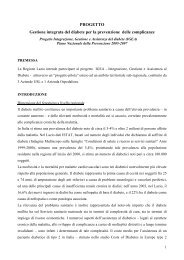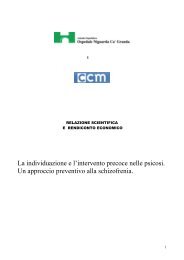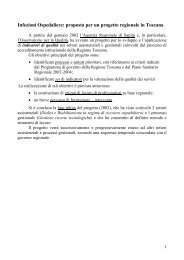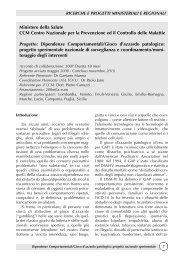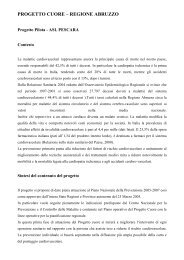Gaining health : analysis of policy development in European ...
Gaining health : analysis of policy development in European ...
Gaining health : analysis of policy development in European ...
Create successful ePaper yourself
Turn your PDF publications into a flip-book with our unique Google optimized e-Paper software.
Chapter 4<br />
130<br />
The ma<strong>in</strong> functions <strong>of</strong> <strong>health</strong> <strong>policy</strong> formulation, coord<strong>in</strong>ation<br />
and regulation are carried out by a number <strong>of</strong> <strong>in</strong>stitutions<br />
under the direct control <strong>of</strong> the M<strong>in</strong>ister <strong>of</strong> Health. 14<br />
Beside these adm<strong>in</strong>istrative functions, some <strong>of</strong> these <strong>in</strong>stitutions<br />
provide <strong>health</strong> services themselves, <strong>in</strong>clud<strong>in</strong>g public<br />
<strong>health</strong> services.<br />
The National Public Health and Medical Officer Service<br />
(NPHMOS) is one <strong>of</strong> the most important agencies <strong>of</strong> the<br />
M<strong>in</strong>istry <strong>of</strong> Health. NPHMOS, headed by the Chief Public<br />
Health Officer, is considered as the government-based<br />
implement<strong>in</strong>g agency for the NPHP. Its central organ is the<br />
National Public Health Centre, which consists <strong>of</strong> national<br />
<strong>health</strong> <strong>in</strong>stitutes. The Chief Public Health Officer is the<br />
Director-General <strong>of</strong> the National Public Health Centre,<br />
which controlled the local organs <strong>of</strong> NPHMOS through<br />
county and city public <strong>health</strong> <strong>of</strong>ficers until a shift to regional<br />
and district levels <strong>in</strong> 2006. NPHMOS <strong>in</strong>stitutes operate<br />
<strong>in</strong> the counties and the capital on the basis <strong>of</strong> the former<br />
sanitary-epidemiology stations. This means a homogeneous,<br />
regimented, government-based authority with national<br />
<strong>in</strong>stitutes and also county and city public <strong>health</strong> <strong>of</strong>fices. In<br />
fact, most prevention activities are developed <strong>in</strong> different<br />
sett<strong>in</strong>gs with outsourc<strong>in</strong>g to NGOs.<br />
S<strong>in</strong>ce the establishment <strong>of</strong> the two-tier local government<br />
system 15 <strong>in</strong> 1990 (which replaced the former “council”<br />
system), local authorities have become key actors <strong>in</strong> the<br />
<strong>health</strong> sector. Although national <strong>policy</strong> determ<strong>in</strong>es the<br />
broad framework for local <strong>policy</strong>, the Constitution guaran-<br />
14<br />
Act CLIV <strong>of</strong> 1997 on Health (1997/16) assigns responsibility for <strong>health</strong><br />
services to the National Assembly, the national Government, the M<strong>in</strong>istry<br />
<strong>of</strong> Health, the National Public Health and Medical Officer Service and <strong>in</strong><br />
general the owners <strong>of</strong> <strong>health</strong> facilities, who s<strong>in</strong>ce 1990 are ma<strong>in</strong>ly local<br />
adm<strong>in</strong>istrations.<br />
15<br />
Act LXV <strong>of</strong> 1990 def<strong>in</strong>ed the basic structure, rights and duties, sources<br />
<strong>of</strong> funds and properties <strong>of</strong> local government. Municipal and county authorities<br />
share responsibilities on the basis <strong>of</strong> the pr<strong>in</strong>ciple <strong>of</strong> subsidiarity.<br />
This means that county authorities take over only those public services<br />
that municipal authorities cannot undertake and are will<strong>in</strong>g to transfer to<br />
the county level.<br />
tees the discretion <strong>of</strong> local government on local affairs, and<br />
this cannot be overruled by the national authorities. The<br />
local authorities are key partners <strong>in</strong> the different prevention<br />
programmes.<br />
Nevertheless, a lack <strong>of</strong> consensus can be seen about the<br />
decentralization <strong>of</strong> the overall adm<strong>in</strong>istrative system, <strong>in</strong>clud<strong>in</strong>g<br />
the regional and district levels. A number <strong>of</strong> governmental<br />
organizations, <strong>in</strong>clud<strong>in</strong>g NPHMOS, were reorganized <strong>in</strong><br />
2007 at regional and district level, replac<strong>in</strong>g the old countyand<br />
city-level system. However, because <strong>of</strong> the wider political<br />
debate, the constitutional basis for such an important<br />
change is still miss<strong>in</strong>g. In future we can expect a shift from<br />
central decision-mak<strong>in</strong>g bodies towards regions and districts<br />
<strong>in</strong> the <strong>development</strong> and implementation <strong>of</strong> policies to<br />
tackle NCD. The planned EU structural funds will be ma<strong>in</strong>ly<br />
distributed accord<strong>in</strong>g to a bidd<strong>in</strong>g system at regional and<br />
district levels.<br />
2.3. How th<strong>in</strong>gs started<br />
2.3.1. The first Health for All <strong>policy</strong><br />
Hungary has long experience <strong>in</strong> develop<strong>in</strong>g strategies<br />
aimed at improv<strong>in</strong>g the <strong>health</strong> <strong>of</strong> the population. The first<br />
CVD prevention programmes <strong>in</strong> cooperation with WHO,<br />
pioneered by the National Institute <strong>of</strong> Cardiology, began <strong>in</strong><br />
the mid-1970s <strong>in</strong> the 17th district <strong>of</strong> Budapest and the city<br />
<strong>of</strong> Pécs.<br />
In December 1987, the Government announced by decree<br />
a long-term programme on <strong>health</strong> promotion, a unique<br />
experiment under socialist conditions <strong>in</strong> Europe. The programme<br />
was to be implemented at the time that basic political<br />
reforms were tak<strong>in</strong>g place. Changes that culm<strong>in</strong>ated <strong>in</strong><br />
the collapse <strong>of</strong> the regime marg<strong>in</strong>alized this <strong>in</strong>itiative, which<br />
disappeared along with the old system by 1990. Hence this<br />
programme cannot be evaluated properly.<br />
The plann<strong>in</strong>g and <strong>in</strong>itiation <strong>of</strong> the long-term <strong>health</strong> promotion<br />
programme <strong>in</strong> Hungary was made possible by a num-<br />
Case studies: <strong>policy</strong> <strong>development</strong> <strong>in</strong> countries for tackl<strong>in</strong>g noncommunicable diseases




